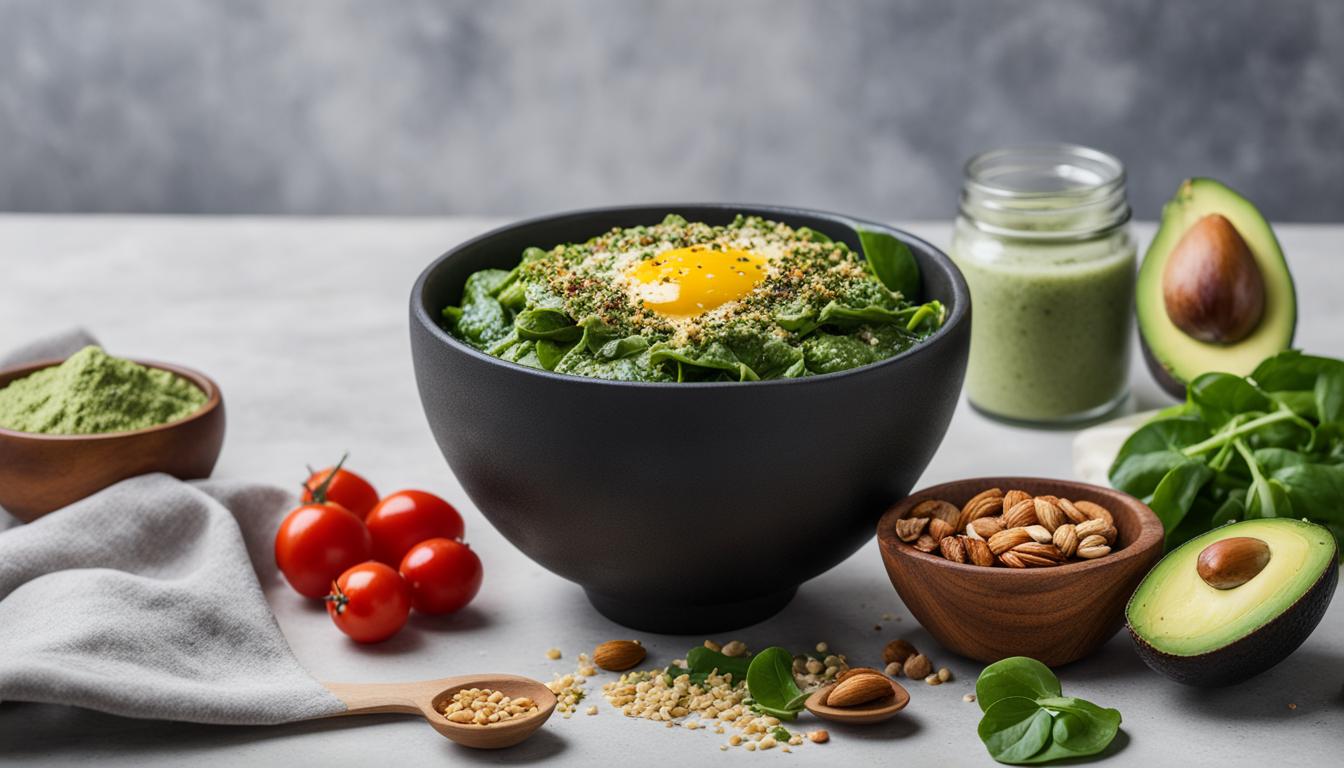Keto Bread vs Gluten-Free Bread: Is Keto Bread The Same As Gluten-Free? Exploring the Popularity, Health Benefits, and Taste Comparison!
Explaining the Popularity of Keto Diet and Gluten-Free Diets
Have you ever noticed how many people around you are embracing the ketogenic diet or going gluten-free? It seems like these dietary approaches have taken the world by storm, and it’s not just a passing fad – there’s actually science behind their growing popularity!
The Rise of the Keto Diet
The ketogenic diet, or keto diet, has gained immense popularity in recent years. But what exactly is it and why are so many people jumping on the keto bandwagon?
Well, the keto diet is a low-carb, high-fat diet that offers a wide range of health benefits. One of the primary reasons for its popularity is its ability to help with weight loss. Studies have found that the keto diet can be more effective for weight loss compared to a low-fat diet, and it also helps in reducing feelings of hunger, leading to a natural reduction in calorie intake.
Not only that, the keto diet has been linked to improved mental clarity, increased energy levels, and even better blood sugar control. This makes it an attractive option for individuals looking to enhance their overall well-being.
The Appeal of Gluten-Free Diets
Similarly, the gluten-free diet has become increasingly popular, with many celebrities and health influencers touting its benefits. So, what’s the deal with gluten-free eating?
Gluten is a protein found in wheat, barley, and rye, and it can cause adverse reactions in individuals with celiac disease or gluten sensitivity. As more people become aware of these conditions, the demand for gluten-free options has skyrocketed.
However, it’s also worth noting that some individuals without gluten-related disorders choose to follow a gluten-free diet due to the perceived health benefits. While more research is needed in this area, there is anecdotal evidence suggesting that a gluten-free diet may alleviate digestive discomfort and improve overall well-being in some individuals.
The Intersection of Keto and Gluten-Free Diets
Now, what happens when the popularity of keto and gluten-free diets collide? This brings us to an interesting discussion about keto bread and gluten-free bread. Is keto bread the same as gluten-free? Are the health benefits and taste comparable?
As we dive deeper into this topic, we’ll uncover the unique characteristics of keto bread and gluten-free bread, explore their health benefits, and even conduct a taste comparison to help you make informed decisions about incorporating these bread options into your dietary lifestyle.
So, stick around as we unravel the mysteries of keto bread and gluten-free bread and discover how they can fit into your healthy eating journey!

What is Keto Bread?
If you’ve been exploring the world of ketogenic diet, chances are you’ve come across the term “keto bread.” But what exactly is it? Keto bread is a type of bread that is low in carbohydrates and high in fat, making it a suitable option for those following a keto lifestyle. Unlike traditional bread, which is made with flour high in carbs, keto bread is typically made with alternative ingredients that are lower in carbs and higher in healthy fats.
One of the key characteristics of keto bread is its low-carb content. According to research published in the American Journal of Clinical Nutrition, low-carbohydrate diets have been shown to effectively support weight loss and improve heart health. This makes keto bread an attractive option for individuals looking to reduce their carbohydrate intake while still enjoying the pleasure of bread.
What is Gluten-Free Bread?
Gluten-free bread has gained immense popularity in recent years, especially among individuals with celiac disease, gluten sensitivity, or those following a gluten-free diet for various health reasons. But what exactly is gluten-free bread?
Simply put, gluten-free bread is a type of bread that does not contain gluten, a protein composite found in wheat, barley, rye, and triticale. The absence of gluten protein is a defining characteristic of gluten-free bread.
It’s important to note that removing gluten from bread can significantly alter its texture and structure, making it more challenging to achieve the light and airy consistency commonly associated with traditional wheat bread.
Now, let’s dive deeper into the absence of gluten protein in gluten-free bread.
Key Differences Between Keto Bread and Gluten-Free Bread
Let’s dive into the main variations in ingredients, nutritional value, and impact on health for keto bread and gluten-free bread. Understanding these key differences can help you make an informed choice that aligns with your dietary needs and health goals.
Ingredients
Keto bread is typically made with low-carb flour alternatives such as almond flour, coconut flour, or flaxseed meal. These ingredients are high in healthy fats and fiber, making them suitable for a ketogenic diet. On the other hand, gluten-free bread often uses non-wheat flours such as rice flour, quinoa flour, or tapioca starch to eliminate gluten. These ingredients may have higher carbohydrate content compared to keto-friendly flours.
Nutritional Value
When comparing nutritional value, keto bread tends to be higher in fat and lower in carbohydrates, fitting well within the macronutrient requirements of a ketogenic diet. Gluten-free bread may have a higher carbohydrate content due to the use of alternative flours, but it may not necessarily be high in fat. It’s important to carefully read the nutrition labels to understand the macronutrient breakdown of each type of bread.
Impact on Health
Choosing keto bread can support your ketogenic lifestyle by helping you stay in ketosis, a metabolic state where your body uses fat for fuel instead of carbohydrates. On the other hand, gluten-free bread is beneficial for individuals with gluten sensitivities or celiac disease, as it allows them to enjoy bread without experiencing adverse health effects associated with gluten consumption.
By considering these differences, you can make a well-informed decision based on your dietary preferences and health needs.
Health Benefits and Considerations of Keto Bread
Now let’s dive into the potential benefits of keto bread, especially when it comes to weight loss and blood sugar control. If you’ve been curious about how keto bread could make a positive impact on your health, then keep reading!
Weight Loss Benefits
One of the most alluring aspects of keto bread is its potential to support weight loss efforts. Research published in the International Journal of Environmental Research and Public Health has found that a low-carbohydrate ketogenic diet can be effective for weight loss. Keto bread, being low in carbohydrates, can be a useful tool for those looking to reduce their overall carb intake while still enjoying a bread-like product.
Furthermore, a study in the American Journal of Clinical Nutrition revealed that a low-carbohydrate diet has been linked to decreased appetite, leading to lower calorie intake, and ultimately aiding in weight loss.
Blood Sugar Control
For individuals looking to manage their blood sugar levels, keto bread presents an appealing option. A study in Diabetes Therapy indicates that a low-carbohydrate diet can lead to improved glycemic control in individuals with type 2 diabetes. As keto bread is significantly lower in carbohydrates compared to traditional bread, it may have a positive effect on blood sugar levels.
Moreover, a review published in Obesity Reviews demonstrated that low-carbohydrate diets can lead to improved insulin sensitivity, which is vital for regulating blood sugar levels and preventing diabetic complications. By incorporating keto bread into a low-carb diet, individuals may experience better blood sugar control.
It’s important to note that while keto bread can offer these potential benefits, it should be consumed as part of a well-rounded, balanced diet. As always, consulting with a healthcare professional or a registered dietitian is a valuable step in making dietary choices that align with your health goals.
Considering these potential advantages, it’s clear that keto bread can be a beneficial addition to the diet for those seeking to manage their weight and blood sugar levels. Whether you’re following a ketogenic lifestyle or simply looking to reduce your carbohydrate intake, keto bread could be a delicious and supportive choice for your health and wellness journey. Plus, the variety of keto bread recipes available also means you can customize your bread to suit your taste preferences and dietary needs!

Health Benefits and Considerations of Gluten-Free Bread
For individuals with gluten sensitivities or celiac disease, gluten-free bread offers several advantages as well as some limitations. Let’s explore the health benefits and considerations of consuming gluten-free bread.
Advantages of Gluten-Free Bread
Gluten-free bread, typically made from alternative flours such as almond flour, coconut flour, or tapioca flour, provides a viable option for those with gluten sensitivities or celiac disease to enjoy bread without adverse reactions. Research has shown that adhering to a gluten-free diet can help alleviate symptoms and promote intestinal healing in individuals with celiac disease (Source).
Moreover, gluten-free bread often contains added nutrients and fiber to compensate for the lack of fortification that occurs in traditional wheat-based bread. Many brands enrich their gluten-free bread with essential vitamins and minerals, making it a potentially healthier choice for individuals with gluten sensitivities.
Limitations of Gluten-Free Bread
One of the main limitations of gluten-free bread is its potential lack of fiber and essential nutrients compared to whole-grain wheat bread. Some gluten-free varieties may contain higher levels of sugar and unhealthy fats to improve taste and texture, which can impact blood sugar levels and overall health if consumed in excess.
Additionally, gluten-free bread may have a denser texture and be more crumbly than traditional wheat bread due to the absence of gluten, which can affect its overall palatability for some individuals.
It’s essential to be mindful of portion sizes and read ingredient labels when choosing gluten-free bread to ensure a balanced nutritional profile and minimize potential downsides associated with certain additives.
Overall, for individuals with gluten sensitivities or celiac disease, gluten-free bread can provide a safe and enjoyable alternative to traditional bread, especially when selected with care to ensure a nutrient-dense and balanced option.
Taste and Texture Comparison
Let’s dig into the delicious details and explore the differences in taste, texture, and overall eating experience between keto and gluten-free bread.
Taste of Keto Bread
Keto bread, typically made with almond flour, coconut flour, and eggs, offers a unique and nutty flavor. The almond flour provides a slightly sweet taste, while the coconut flour adds a hint of freshness. The eggs contribute to a rich and savory undertone, making keto bread a flavorful choice for those following a low-carb diet.
Additionally, keto bread can be customized with various seasonings and herbs, allowing for a versatile range of flavors to suit different preferences. Whether you prefer a classic savory taste or a hint of herbs and spices, keto bread can be tailored to cater to your taste buds.
Taste of Gluten-Free Bread
Gluten-free bread, on the other hand, is commonly made with ingredients such as rice flour, tapioca flour, and xanthan gum. The taste of gluten-free bread is often neutral, with a mild earthy undertone. Due to the absence of wheat and gluten, the flavor profile of gluten-free bread is less pronounced compared to traditional wheat-based bread.
While some may perceive the neutral taste of gluten-free bread as less flavorful, its subtlety allows for versatile pairings with various spreads and toppings, making it a great canvas for both sweet and savory toppings.
Texture of Keto Bread
When it comes to texture, keto bread offers a moist and dense crumb, resembling the texture of traditional wheat bread. The combination of almond flour and eggs provides a substantial and slightly chewy texture, offering a satisfying mouthfeel with each bite. The use of baking powder or baking soda helps keto bread rise, resulting in a soft and airy texture.
Texture of Gluten-Free Bread
Gluten-free bread tends to have a lighter and airier texture compared to keto bread. The use of ingredients like rice flour and xanthan gum contributes to a softer and more delicate crumb structure. While some variations of gluten-free bread may be denser, many recipes aim to achieve a light and springy texture, providing a pleasant eating experience.
Ultimately, the choice between keto bread and gluten-free bread in terms of taste and texture comes down to personal preference. Both options offer unique sensory experiences, and the decision may depend on individual dietary needs and flavor inclinations.
Next up, let’s take a closer look at the health benefits of keto and gluten-free bread to help you make an informed decision when incorporating them into your diet.
Providing Delicious Recipes and Alternatives
One of the best parts of following a ketogenic or gluten-free lifestyle is discovering new recipes that open the door to a world of delicious and healthy options. A staple in many households is bread, and fortunately, there are fantastic homemade and commercially available options for those following keto or gluten-free diets.
Homemade Keto and Gluten-Free Bread Recipes
Creating your own keto and gluten-free bread can be a rewarding experience. Not only do you have control over the ingredients used, but the aroma of freshly baked bread filling your kitchen is unbeatable. A simple search online will reveal countless recipes for keto and gluten-free bread, many of which have been developed and refined by experienced bakers and chefs. These recipes often use almond flour, coconut flour, or psyllium husk as primary ingredients, ensuring a low-carb and gluten-free final product.
When making bread at home, it’s essential to understand the unique properties of keto and gluten-free flours. For instance, almond flour and coconut flour have different absorption rates compared to traditional wheat flour, and they may require the addition of extra eggs or liquids to achieve the desired texture.
Commercially Available Options
For those who prefer convenience or lack the time to bake their own keto or gluten-free bread, the good news is that there are many commercially available options on the market today. These bread alternatives are often found in specialty health food stores or well-stocked supermarkets.
When selecting commercially available keto or gluten-free bread, it’s crucial to read the labels and nutritional information. Some products may contain added sugars, high-carb fillers, or other ingredients that don’t align with a ketogenic or gluten-free lifestyle. Look for bread that is specifically labeled as keto-friendly or gluten-free, and ideally, opt for those made with natural, whole food ingredients.
Experimenting with different homemade recipes and exploring commercially available keto and gluten-free bread options can lead to finding the perfect bread alternative that not only satisfies your cravings but also supports your health and well-being.
Summarizing the Key Points
After diving into the world of ketogenic and gluten-free bread, it’s clear that both options have their unique benefits and considerations. Keto bread is low in carbohydrates and high in healthy fats, making it suitable for those following a ketogenic diet. On the other hand, gluten-free bread caters to individuals with celiac disease or gluten sensitivity.
We explored the health benefits of both types of bread, delving into the impact on blood sugar levels, weight management, and digestive health. Taste-wise, both keto and gluten-free bread have come a long way in terms of flavor and texture, with many delicious options available on the market.
Now, let’s discuss how to choose between keto bread and gluten-free bread based on individual dietary needs.
Choosing Between Keto Bread and Gluten-Free Bread
When it comes to selecting the right type of bread for your dietary needs, it’s essential to consider your personal health goals and any underlying health conditions. Here are some practical guidelines to help you make an informed choice:
Dietary Goals
If your primary goal is to achieve ketosis and maintain a low-carb, high-fat diet, then keto bread would be the preferred option. Keto bread is crafted specifically to keep carbohydrate levels low, thereby supporting the body’s ketogenic state.
On the other hand, if you are focused on eliminating gluten from your diet due to celiac disease or gluten intolerance, then gluten-free bread is the way to go. It provides a safe and healthy alternative for individuals with gluten-related health concerns.
Nutritional Requirements
Consider your overall nutritional needs when choosing between keto bread and gluten-free bread. Keto bread often contains healthy fats and moderate protein, which can be beneficial for individuals following a low-carb, high-fat diet.
Gluten-free bread, while free from gluten, may sometimes lack the same level of healthy fats found in keto bread. If you opt for gluten-free bread, be mindful of obtaining essential nutrients from other sources in your diet to ensure balanced nutrition.
Taste and Texture Preferences
Take your taste and texture preferences into account. Some individuals may prefer the distinct taste and texture of keto bread, especially if they enjoy the richness of ingredients like almond flour and seeds. On the other hand, gluten-free bread offers a wider variety of flavors and textures due to the use of alternative grains and ingredients.
Ultimately, the choice between keto bread and gluten-free bread depends on aligning your dietary needs with your health goals and personal preferences. By understanding the distinct advantages of each type of bread, you can make an informed decision that supports your overall well-being.


